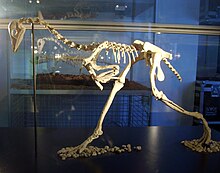| Patagopteryx Temporal range: Late Cretaceous,
| |
|---|---|

| |
| Skeleton restoration | |
| Scientific classification | |
| Domain: | Eukaryota |
| Kingdom: | Animalia |
| Phylum: | Chordata |
| Clade: | Dinosauria |
| Clade: | Saurischia |
| Clade: | Theropoda |
| Clade: | Avialae |
| Clade: | Euornithes |
| Clade: | †Patagopterygiformes |
| Family: | †Patagopterygidae Alvarenga & Bonaparte, 1992 |
| Genus: | †Patagopteryx Alvarenga & Bonaparte, 1992 |
| Species: | †P. deferrariisi
|
| Binomial name | |
| †Patagopteryx deferrariisi Alvarenga & Bonaparte, 1992
| |
Patagopteryx is an extinct monotypic genus of euornithean dinosaurs that lived during the Late Cretaceous, around 80 mya, in what is now the Sierra Barrosa in northwestern Patagonia, Argentina.[1] About the size of a chicken, it is the earliest known unequivocal example of secondary flightlessness: its skeleton shows clear indications that the ancestors of Patagopteryx were flying animals, though other studies find earlier diverging theropods to be secondarily flightless.[2]

Located in strata of the Santonian Bajo de la Carpa Formation, the original remains were discovered by Oscar de Ferrariis, Director of the Natural History Museum of the Comahue National University in Neuquén around 1984–5. He passed them onto noted paleontologist José Bonaparte, who described the species Patagopteryx deferrariisi in 1992.
- ^ H. M. F. Alvarenga and J. F. Bonaparte. 1992. A new flightless landbird from the Cretaceous of Patagonia. Los Angeles County Museum of Natural History, Science Series 36:51-64 [J. Hunter/J. Hunter/J. Hunter]
- ^ Kiat, Yosef; O’Connor, Jingmai K. (20 February 2024). "Functional constraints on the number and shape of flight feathers". Proceedings of the National Academy of Sciences. 121 (8). doi:10.1073/pnas.2306639121. ISSN 0027-8424.